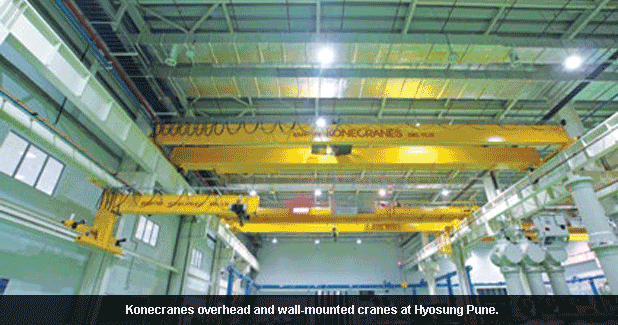
Safe Lifting solutions
The state-of-the-art facility in the Khed City Economic Zone near Pune produces high-voltage gas-insulated switch gear, transformers, circuit breakers and other related components using the latest lean manufacturing technology to contribute to the government's Make in India programme.
Hyosung says the new plant - which is 30 per cent more space-efficient than typical older plants - is purpose-built to make a massive contribution in enhancement of electrical transmission efficiency and reliability for the Power Grid Corporation of India. The 20 CXT overhead Konecranes of 5-20 tonnes and the eight 3.2 tonnes wall travelling cranes installed at the Pune plant were all manufactured in India to deliver the safety, accuracy and reliability vital to their role of assembling switchgear up to 800 kVa, including the critical task of accurately joining major assemblies before SF6 gas insulation gas is introduced.
The Konecranes e-Ton (economy per tonnes) semi-modular cranes involved are from a new Konecranes India range of winch cranes of 5-50 tonnes capacity, which are based on Konecranes decades' of experience on the sub-continent producing low-maintenance, highly cost-efficient and ergonomic cranes with outstanding Total Cost of Ownership (TCO) benefits.
Hyosung's cranes feature variable speed performance to provide the smooth starting, stopping and precision performance required to achieve the standards of performance needed to service the needs of the Power Grid Corporation of India.
Everything in the plant is keyed to the safety, precision and reliability standards of product manufacture and supply required by the Power Grid Corporation, says the Plant's Director and Head of Operation, SC Shin.
Shin designed the plant to be a model of efficiency in building and delivering quality switchgear as and when needed by the customer, using the highest standards of local production to ensure product is available when and where it is needed.
?If the customer has a need for product to solve problem in the grid, a supplier can't take days to respond to their needs. The customer needs a local supplier who can respond to their needs to maintain the integrity of the grid,' says Shin.
The new Hyosung plant achieves its objectives through thorough planning and development of a purpose-built plant that is among the best in the Hyosung worldwide group, which, with revenues of more than $17 billion a year, spans 50 bases in Asia, America and Europe with customers in 130 countries.
The global Power and Industrial Systems Group of which the new plant is part subscribes to Hyosung's philosophy of eco-conscious, efficient management, with the new Pune plant being more than 30 per cent more space-efficient than earlier plants of its type.
Shin says the design philosophy for the new plant extended to the throughout the specification and selection process for machinery and equipment contained within it, to ensure that the best and most suitable technology was chosen, including the cranes, which are vital to production.
'We cannot produce without cranes. And without reliable cranes, there can be delays,' says Shin, who, with his colleagues, considered three major brands of crane before selecting Konecranes.
Shin was impressed during his visit to Konecranes modern crane production facility nearby in Pune, which serves the growing needs of the Asian market, producing CXT, e-Ton and other process cranes to the highest global standards of quality and safety. In addition to outstanding manufacturing systems and technology, Shin was impressed with the Konecranes hoist and the standards Konecranes was achieving manufacturing product that met the requirements of the government's Make in India programme. Make in India requirements - as well as the availability of prompt service and maintenance backup from a local source - were very important to the client, says Shin.
The final selection and equipment specification process was impressively streamlined, said Shin, with Konecranes India employing its local knowledge to achieve prompt compliance with Indian statutory regulations and engineering and manufacturing requirements.
For example, where cranes and related steel structures are typically manufactured together in Hyosung's home base of Korea, they are manufactured separately in India. 'This was not a problem to us,? said Konecranes India Assistant Manager ? Equipment Sales, Pankaj Potdar. 'The structures we built in compliance with local requirements were some of the highest quality ever.'
'Where structural steel variations of 5-20 mm are typical, our Konecranes structure was zero-zero variation, which was unprecedented.'
'Installation and commissioning also was achieved smoothly - when the final result was viewed by the Konecranes CEO Panu Routila, he said this plant was a showroom for Konecranes technology and a showplace for Hyosung efficiency.'


 +91-22-24193000
+91-22-24193000 Subscriber@ASAPPinfoGlobal.com
Subscriber@ASAPPinfoGlobal.com